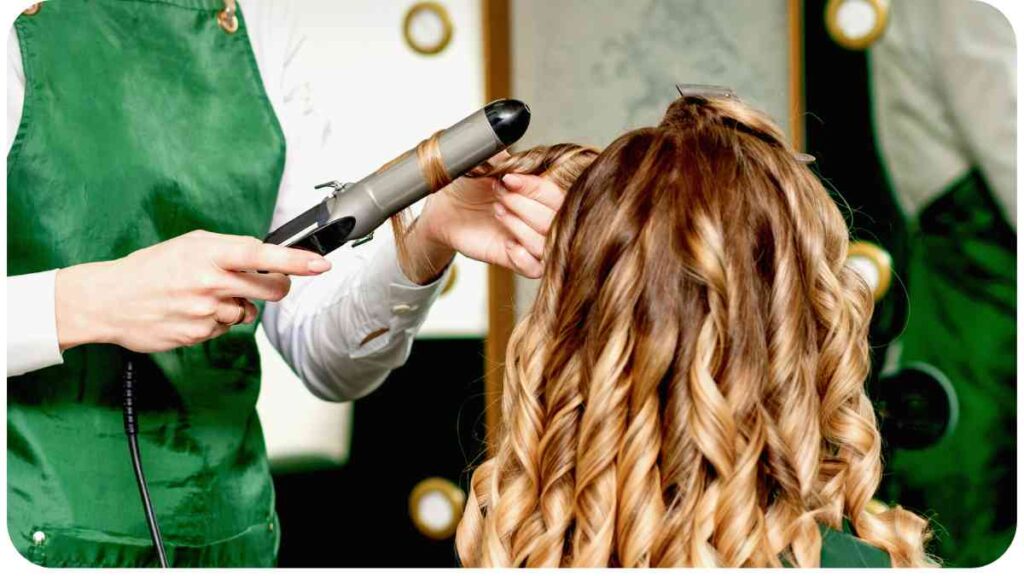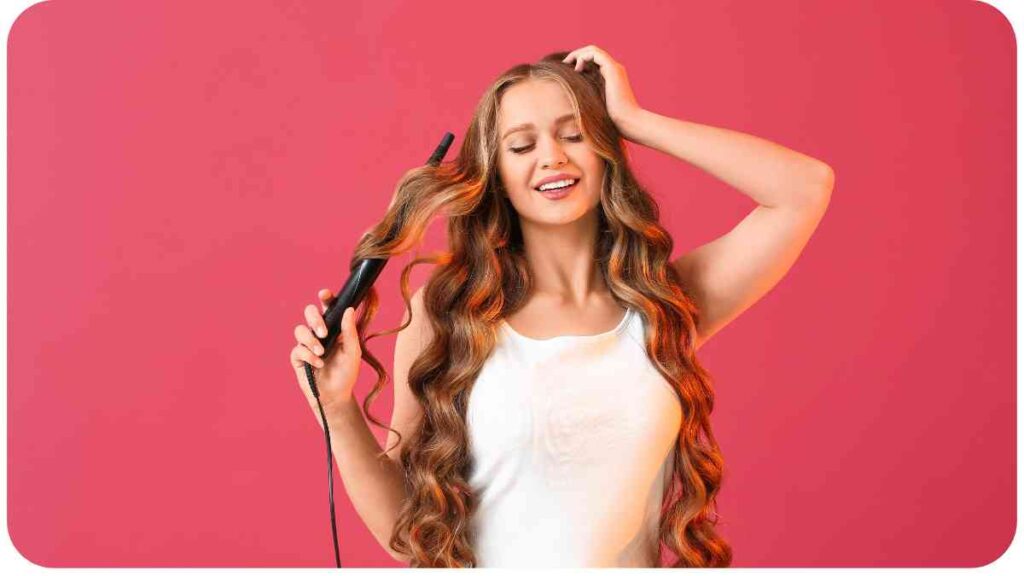Welcome to our comprehensive guide on troubleshooting your curling iron. Whether you’re a professional stylist or a regular user, encountering issues with your curling iron can be frustrating. In this article, we will address common problems, provide effective troubleshooting techniques, and offer maintenance tips to help you optimize your curling iron’s performance and extend its lifespan.
By the end of this guide, you’ll have the knowledge and tools to ensure your curling iron delivers flawless curls every time.
| Takeaways |
| Troubleshoot common curling iron issues effectively |
| Understand the importance of heat settings for different hair types |
| Clean the curling iron barrel regularly for even heat distribution |
| Properly maintain and store your curling iron to prolong its lifespan |
| Use recommended products for curling iron care |
| Follow safety guidelines to prevent heat damage to your hair |
| Refer to credible resources for further information and troubleshooting techniques |
2. Understanding Curling Irons
Before diving into troubleshooting, it’s essential to understand how curling irons work. Curling irons use heat to transform straight hair into beautiful, bouncy curls. They consist of a heated barrel, clamping mechanism, and a handle. The barrel can be made of various materials such as ceramic, tourmaline, or titanium, each offering different benefits.
Heat can impact your favorite fragrances. Dive into the science of how temperature affects perfumes and discover ways to protect them. Explore the impact of temperature on fragrances to keep your scents intact and delightful.
Table 2.1: Types of Curling Iron Barrels
| Barrel Material | Description | Benefits |
| Ceramic | Even heat distribution, smooth curls, reduced frizz | |
| Tourmaline | Generates negative ions, smooths hair, reduces static | |
| Titanium | Quick and even heating, lightweight, ideal for thick hair |
Understanding the barrel material will help you choose the right curling iron for your hair type and troubleshoot any issues related to heat distribution or frizz.
Achieving salon-quality hair at home is possible with the right tools and techniques. Learn how to create stunning hairstyles with ease and confidence. Check out our guide on salon-quality hair at home to get started today.
3. Common Issues with Curling Irons

Curling irons can experience a variety of problems that hinder their performance. Identifying these issues is crucial for effective troubleshooting. Here are the common issues you may encounter:
- Overheating: A curling iron getting too hot to handle or becoming scorching hot during use.
- Uneven Heat Distribution: Inconsistent heating along the barrel, resulting in uneven curls.
- Curling Iron Not Heating Up: No heat or insufficient heat generated by the curling iron.
Now that we have identified the common issues, let’s explore the troubleshooting techniques to resolve them and ensure optimal curling iron performance.
4. Troubleshooting Techniques
4.1 Overheating
Overheating can cause discomfort and damage to your hair. Here are a few tips to troubleshoot this issue:
- Check the Temperature Settings: Ensure that you are not setting the temperature too high. Different hair types require different heat levels. Fine hair is more vulnerable to heat damage, so opt for lower temperatures, while thick or coarse hair may require higher temperatures.
- Test the Iron’s Temperature: Use a heat-resistant glove or a temperature testing device to examine the actual temperature of the curling iron. If it exceeds the set temperature, it might be time to replace your curling iron.
If you’re facing issues with your hair straightener, our quick guide can help. Discover common problems and effective solutions for a smooth hair straightening experience. Read more about hair straightener issues to troubleshoot with ease.
Remember, always prioritize the health of your hair and opt for lower heat settings when possible.
Table 4.1: Recommended Temperature Settings for Different Hair Types
| Hair Type | Recommended Temperature Range |
| Fine hair | 250°F – 300°F (120°C – 150°C) |
| Normal hair | 300°F – 350°F (150°C – 180°C) |
| Thick hair | 350°F – 400°F (180°C – 200°C) |
4.2 Uneven Heat Distribution
Inconsistent heat distribution can lead to unsightly curls. To resolve this issue, consider the following tips:
- Clean the Barrel: Product buildup on the curling iron’s surface can disrupt heat distribution. Regularly clean the barrel with a damp cloth or alcohol wipe to ensure even heating across the entire surface.
- Rotate the Barrel: While curling your hair, ensure you rotate the curling iron gently and consistently. This technique will expose all sections of the barrel to your hair and promote uniform curling.
Table 4.2: Comparing Curling Iron Rotations and Their Effects
| Rotation Style | Resulting Curl
| Direction | Description |
| Clockwise | Creates curls that wrap towards your face |
| Counter-clockwise | Creates curls that wrap away from your face |
| Alternating | Creates a more natural look with curls facing different directions |
4.3 Curling Iron Not Heating Up
If your curling iron is not heating up or generating insufficient heat, try these troubleshooting techniques:
- Check the Power Source: Ensure that the curling iron is plugged in correctly and that the power source is functional. Try plugging it into a different outlet to rule out any electrical issues.
- Inspect the Cord: Examine the cord for any frayed or damaged sections. If you notice any, it might be time to replace the curling iron or seek professional repair.
- Allow Sufficient Heat-Up Time: Give your curling iron enough time to heat up before using it. Most curling irons require a few minutes to reach the desired temperature.
Remember to always follow the manufacturer’s instructions and consult a professional if the problem persists.
Understanding your hair’s porosity is key to maintaining healthy locks. Our comprehensive guide provides insights and tips for managing different hair types. Learn more about hair porosity and how it affects your hair care routine.
5. Tips for Proper Curling Iron Maintenance

To ensure the longevity and performance of your curling iron, follow these maintenance tips:
- Clean the Barrel Regularly: Remove any hair product residue from the barrel after each use. Use a damp cloth or an alcohol wipe to gently clean the surface.
- Store Properly: Allow the curling iron to cool down completely before storing it. Store it in a safe, dry place where it won’t get damaged.
- Avoid Excessive Force: Be gentle when opening or closing the clamp to prevent any damage to the curling iron.
- Protect the Cord: Avoid wrapping the cord tightly around the curling iron, as it may cause damage. Instead, loosely coil the cord when storing.
By following these simple maintenance techniques, you can extend the lifespan of your curling iron and ensure its optimal performance.
6. Recommended Products for Curling Iron Care
Using the right products can enhance the performance of your curling iron and maintain the health of your hair. Here are a few recommended products for curling iron care:
Table 6.1: Recommended Products for Curling Iron Care
| Product | Description |
| Heat Protectant Spray | Shields hair from heat damage and helps lock in moisture during styling |
| Curling Iron Cleaner | Removes stubborn product residue and buildup from the curling iron barrel |
| Thermal Styling Serum | Provides added protection against heat and enhances shine and softness |
| Silicone Heat Mat | Protects surfaces from heat damage and provides a safe resting spot |
Using these products in conjunction with proper curling iron maintenance will ensure both the health of your hair and the longevity of your styling tool.
Ever wondered why your silver jewelry turns black? Explore the comprehensive guide on jewelry tarnish to learn the causes and how to prevent it. Discover more about jewelry tarnish and keep your jewelry shining.
7. Frequently Asked Questions (FAQs)
7.1 How often should I clean my curling iron?
It’s recommended to clean your curling iron after every use or at least once a week, depending on how frequently you style your hair. Regular cleaning helps maintain heat distribution and prevents product buildup.
7.2 Can I use a curling iron on wet hair?
No, it’s not advisable to use a curling iron on wet hair. Wet hair is more susceptible to damage and can cause the curling iron to sizzle or burn your hair. Make sure your hair is dry before using any heat-styling tool.
7.3 How long should I wait for my curling iron to heat up?
The heating time varies depending on the curling iron model. On average, most curling irons take 1-2 minutes to reach the desired temperature. Refer to the manufacturer’s instructions for specific heating times.
8. Conclusion
In conclusion, troubleshooting your curling iron can be simplified with the right knowledge and techniques. Understanding the common issues, implementing proper troubleshooting steps, and maintaining your curling iron will ensure its optimal performance.
Remember to choose the appropriate heat settings, clean the barrel regularly, and follow proper haircare practices to enjoy beautiful and long-lasting curls. By incorporating these tips and fixes, you’ll be able to overcome any challenges, enhance your styling experience, and achieve the gorgeous curls you desire.
Further Reading
Here are some additional resources that can provide further insights and information on troubleshooting and fixing common issues with curling irons:
- Fixit Club: Hair Curler Repair: This website offers detailed guides and tutorials on repairing various hair curlers and provides step-by-step instructions for common troubleshooting techniques.
- Self: Curling Iron Mistakes You Might Be Making: Discover common mistakes people make when using curling irons and learn how to avoid them. This article provides helpful tips and techniques for achieving perfect curls.
- Beauty Crew: Fixes to Common Curling Problems: Uncover expert advice on solving common curling iron issues. From troubleshooting overheating problems to troubleshooting uneven curls, this article offers practical solutions and tips.
Explore these resources to delve deeper into troubleshooting your curling iron and gain more in-depth knowledge to enhance your curling experience.
FAQs
Got some burning questions about troubleshooting your curling iron? Check out these frequently asked questions:
Can I use my curling iron on damp hair?
It is best to avoid using a curling iron on damp or wet hair. Moisture in the hair can cause sizzling, damage, or even burns. Ensure your hair is dry before using any heat-styling tools.
How often should I replace my curling iron?
The lifespan of a curling iron varies depending on usage and maintenance. Generally, it is recommended to replace your curling iron every 2-3 years to ensure optimal performance and safety. If you notice any signs of malfunction or damage before that time, it’s wise to replace it sooner.
How can I prevent my curls from falling out quickly?
To make your curls last longer, try applying a lightweight hairspray or a curl hold spray before and after curling. Additionally, wrap each curl around your finger and secure it with a hairpin while it cools. This will help set the curl and keep it intact.
Why is my curling iron not turning on?
If your curling iron is not turning on, first check if it’s properly plugged into a functioning power source. Ensure the cord is not damaged or frayed. If everything appears to be in order and the curling iron still doesn’t turn on, it might be time to replace it or consult a professional for repair.
How can I prevent heat damage to my hair when using a curling iron?
To protect your hair from heat damage, always apply a heat protectant spray before using any hot styling tools. Additionally, be mindful of the temperature settings, and avoid excessive heat exposure by not holding the curling iron on a single section for too long.

Hi, you! I’m Hellen James. I’m a beauty and fashion writer who loves to make the world a little more stylish and I’d love for you to join me in the fun! I’ve been writing about beauty and fashion since I was a kid, but it wasn’t until recently that I really knew what it meant to be a real expert.

